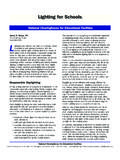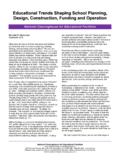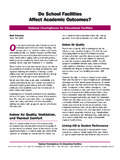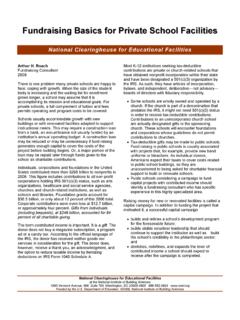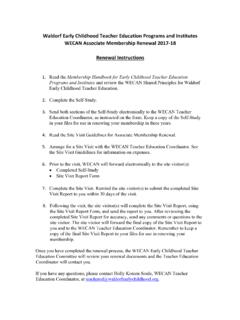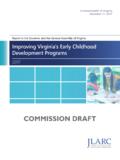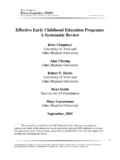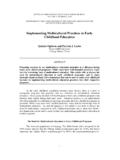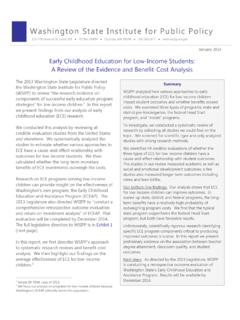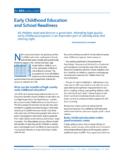Transcription of Early Childhood Centers - NCEF
1 Early Childhood Centers National Clearinghouse for Educational Facilities Dan Butin and Jennifer Woolums 2007-2008 school year data indicates that more than 80. 2009 percent of all 4-year-olds attend some kind of preschool program in the United States. About half of those (39. percent of all 4-year-olds) are enrolled in some kind of Early Childhood Centers have become a common and public program (state pre-K, Head Start or special necessary part of millions of Americans' lives. More education), with the other half enrolled in a private women in the workforce, longer workweeks, and program. Of the thirty-eight states that fund preschool educational research supporting the importance of Early programs, thirty-one state programs have an income education have all contributed to the rise of Early requirement (Barnett 2008: 4 5). Childhood Centers throughout the United States. Today, more than 30 percent of children under the age of three With increased national attention on the pre-school and almost 50 percent of children between the ages of years, educators and design professionals should care- three and five attend an Early Childhood center for some fully consider how and when to provide sufficient space part of their day (Children's Defense Fund 1999).
2 To house this new population. The design of such facili- ties needs to ensure that age-appropriate developmental An Early Childhood center is considered a nonresidential activities, many of which require considerable space and facility that provides care for at least 13 children. This storage, can be carried out effectively in Early Childhood digest focuses on how design can improve the quality of classrooms (Stevenson 2007: 5). such Centers , where quality is seen as the health, safety, and appropriate development of the child (see NAEYC Key Spaces in Early 2000 for comprehensive accreditation guidelines). Childhood Centers Education Trends The Early Childhood center is traditionally composed of six main areas: the classroom(s), an outdoor space, a Researchers have identified a child's first three years as multipurpose room, a health center , a teachers' work- critical for the development of language, attention span, space, and an administrative office. All spaces in an social skills, and problem-solving capabilities (Carnegie Early Childhood center should be easily accessible for Corporation 1994: 3).
3 Quality Early Childhood Centers handicapped students and meet Americans with promote school readiness, enhance verbal ability, and Disabilities Act (ADA) and local guidelines concerning decrease the likelihood of reading difficulties later in accessibility (Office of Civil Rights 1999). An Early school. One recent study found that the effects of quality Childhood center that operates a full-day program may care persisted even into adulthood (quoted in Children's also need a food preparation area. In addition, Defense Fund 1999). consideration should be given to an entrance area that According to Kenneth Stevenson, in many school provides a comfortable and inviting place for parents and districts, mandatory kindergarten for five-year-olds was care-givers to drop off and pick up their children. Such a unusual until a few years ago. Now talk abounds of space can serve the important function of providing an expanding Early Childhood programs to include three- informal area for discussions between parents, teachers, and four-year-olds and, in some cases, babies and and administrators.
4 Toddlers (Wilen, 2003). At a time when high-stakes Classroom. One resource recommends the size of testing drives educational accountability, one key children's group rooms at 750 square feet for infant argument for universal schooling of pre-kindergarteners rooms, 850 square feet for toddler rooms, and 1,000. is this: Children who do not come to school ready to square feet for preschool and school-age rooms (Olds learn are destined to struggle throughout their 2001:112). Research has also shown that classroom educational experience, and are more likely to fail. size should be between 42 and 50 square feet per child. National Clearinghouse for Educational Facilities at the National Institute of Building Sciences 1090 Vermont Avenue, NW, Suite 700, Washington, DC 20005-4905 888-552-0624 Funded by the Department of Education 2009, National Institute of Building Sciences 2 Early Childhood Centers While many states require a minimum of 35 square feet appropriate. High shelving should be provided to store per child, a larger classroom allows more programmatic diapers, towels, and the like.
5 Flexibility, provides space so children can engage in concurrent quiet and active play, and decreases Outdoor space. An outdoor space should allow for both aggressive behavior (Moore 1987: 59 62). free and structured play. Outdoor space can be seen as an extension of the indoor environment, with a garden, a It is also important that the classroom have a high quiet area, and a dramatic play area (North Carolina degree of spatial differentiation (Sanoff 1995: 8 9). School Design Clearinghouse 1998). A covered outdoor Activity areas may be separated by physical objects space should be available for playtime during inclement such as movable partitions and cabinets or by visual weather. Shading is also recommended to avoid cues such as different flooring materials, wall colors, excessive sun for young children. A hard surface should and changes in lighting and ceiling or floor height be available for bicycles, and playground equipment (Passantino 1993: 11; Caples 1996: 15).
6 Such distinct should be appropriately scaled. Rubber flooring or and well-defined boundaries support social interaction, another resilient surface should be used throughout to encourage exploratory behavior, and prevent prevent major accidents and injuries. Fencing around interruption of ongoing play. In general, the classroom the outdoor space is an important safety and security should have at least four distinct activity zones (Lowman feature. and Ruhmann 1998: 12 13). Multipurpose room. A multipurpose room may be used Gross-motor skill zone. Both toddlers and for napping, eating, or large group activities. This space preschool-age children need space to dance, climb, may also be used for parents and volunteers if a jump, and move things. The space should be large dedicated space for such activities is not available. enough to accommodate structures, such as a slide Providing private spaces in the multipurpose room will or a tunnel, and be open enough to allow for push- allow for parent conferences, adult interaction, and a and-pull and riding toys.
7 Reading area to review informational materials provided Dramatic play zone. Make believe and pretend play for parents. In general, the space should be flexible and are important for pre-kindergarten youth. Providing equipped with modular furniture, multiple lighting zones, "home- center " props, such as kitchen appliances, and numerous electrical and data outlets. living room furniture, or a theater area, facilitates such play. While the dramatic play zone should be Health center . The health center should include a adjacent to the gross-motor skill zone to allow for waiting area, examination room, toilet, rest area, and easy movement between the two, a clear division office. Furnishings should include lockable cabinets for between the spaces should be visible to promote a records and medications, a lockable refrigerator with sense of semiprivate space. icemaker, and partitions to allow for privacy. Arts and crafts zone. This is the "wet" area of the Teachers' workspace.
8 This area should provide space room where children can experiment with sand, for teacher preparation and relaxation. The space should water, paint, paste, and other messy materials. The accommodate private activities, such as telephone arts and crafts zone should be next to a water conversations and reading, group activities, and source, such as a sink and gooseneck faucet, and collaborative planning. It should be wired for voice, should have a washable floor covering. Good task video, and data equipment and furnished with lighting is also important for doing art projects. appropriate outlets and room for computers, copy Quiet zone. Young children need personal space machine, file cabinets, professional library, refrigerator, that permits intimate interaction with an adult and and television. Teachers should be able to lock the provides a space for solitary play, looking at books, workspace. or simply resting. The quiet zone should have carpeting, comfortable chairs and pillows, a low Administrative area.
9 The administrative area should be bookshelf for books and stuffed toys, and a space located directly adjacent to the center 's entry so that (that may need to be out of reach of toddlers) for school officials may observe and supervise individuals objects such as plants or an aquarium. entering and leaving the premises. It should provide adequate space for secretarial and administrative The classroom should also have a self-contained personnel as well as for computers, faxes, phones, copy bathroom that is equipped for toilet training and diaper machines, and filing cabinets. A waiting area for parents changing. The toilet and all fixtures should be age and toilets for adult use should also be available. National Clearinghouse for Educational Facilities at the National Institute of Building Sciences 1090 Vermont Avenue, NW, Suite 700, Washington, DC 20005-4905 888-552-0624 Funded by the Department of Education 2009, National Institute of Building Sciences Early Childhood Centers 3.
10 Key Issues in Designing But they often fear new places and develop Early Childhood Centers separation anxiety from their primary caregivers. Some implications for design include providing a Research has shown that well-functioning Early wide variety of activity Centers , places for group Childhood Centers are not just scaled-down versions of activities, and a play/pretend area that can elementary schools or simply open play spaces. Early encourage dramatic play. Childhood Centers should address particular design issues, such as those described below, to achieve a Discovery and play. The environment should permit safe, enjoyable, and educational environment. growth and discovery. Young children need spaces where they feel both autonomous and masterful. Safety and health. The safety and health of the child is Furnishings should be light and easily moved, shelving of paramount importance in the Early Childhood center . should be at the appropriate height, and space should Safety features such as fastened carpeting, scald-proof permit active and quiet recreation.
